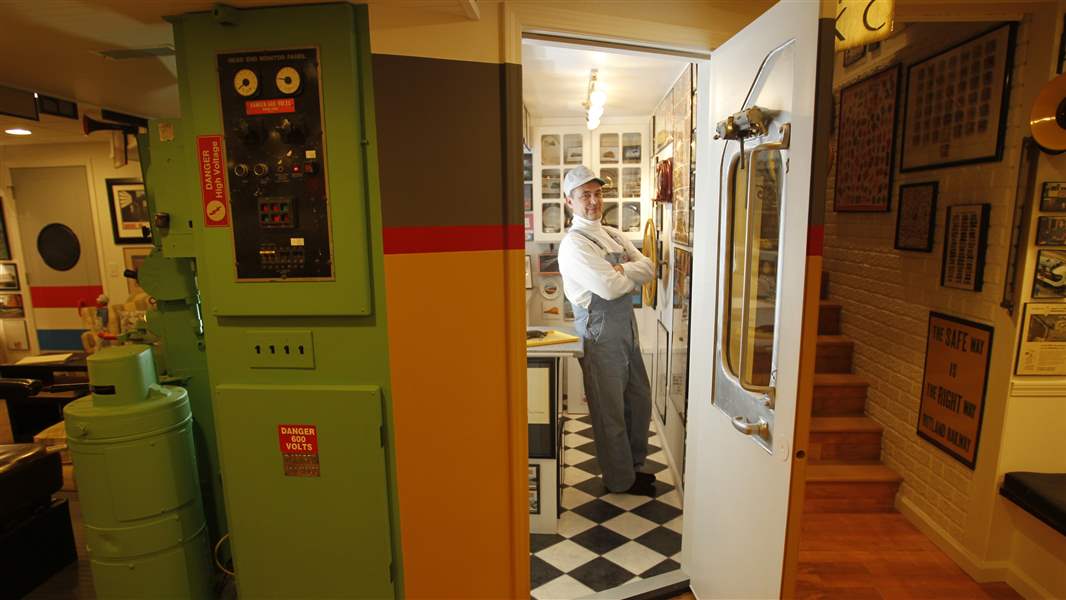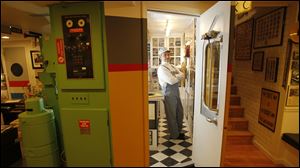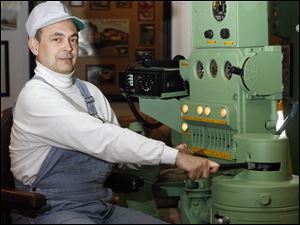
My Space: He’s been workin’ — and livin’ — on the railroad
4/24/2011
Steve Rathke, who works as a train engineer, is pictured in the kitchen area of a special room in his home that, like a museum, is filled with train items and memorabilia.
The Blade/Amy E. Voigt
Buy This Image

Steve Rathke, who works as a train engineer, is pictured in the kitchen area of a special room in his home that, like a museum, is filled with train items and memorabilia.

Steve Rathke works a control stand from a 1951 General Motor locomotive, including an operator's chair and control panel with throttle and brake handles that he restored.
When Steve Rathke says, "This has given me signals for years," he’s not speaking New Age.
His hand rests on a three-foot diameter canister with softball-sized red, green, and yellow lights, once installed next to the tracks along Sandusky Bay. He’d driven past it hundreds of times, checking the lit color to determine his next move as he hauled millions of pounds of freight between Toledo and Pittsburgh. When the signal was replaced, the railroad gave it to him (he’d asked for it) and it’s displayed with hundreds of other railroadiana in his 1,600-square-foot basement.
An exuberant spirit, Mr. Rathke, 44, is fond of wearing the traditional engineer’s hickory-striped overalls and Kromer cap. He doesn’t give a hoot when the guys at work tease him about being dressed for Halloween.
"When I was a child, engineers wore that," he says. "I am living out my childhood dream."
And his remarkable railroad museum is nearly done after 18 months of work.
A 600-pound side window from a cab (the locomotive in the front where the engineer and conductor sit) slides open between a kitchenette and lounge area. Nearby is a 1951 control stand, including the operator’s seat, throttle, brake handle, and a railroad-issued monitoring radio.
"I stripped it and repainted it the original color, ‘cab-apple’ green," says Mr. Rathke, of Springfield Township.
There’s a crossing bell, crossing lights, lanterns, a semaphore (an antique signal), and an old steam whistle, all working. Four train doors (150-200 pounds each) have been set into steel doors that lead to work and storage rooms. A rusty blue door, untouched for decades, bears the ominous: DANGER 600 VOLTS. Walls are covered with safety posters and brochures, photos of him as a kid on trains, schedules, timetables, and paraphernalia from the grand opening of Toledo Union Station in 1950, which his father, Jim Rathke, attended when he was 6.
The kitchenette has china that once served train passengers, menus, place mats, napkins, and kiddie bibs. Three large frames are filled cheek-by-jowl with railroad matchbooks, many of them with attractive graphics. There are disposable ashtrays, decks of cards, and paper cigar bands.
"It shows the pride the railroad would have in their services," he says with infectious enthusiasm.
Mr. Rathke is a third generation railroad buff, but the first to exploit the patrilineal fascination into vocation as well as avocation. Growing up in West Toledo, his family would get ice cream on summer evenings and go to a handful of favorite spots to watch trains. They took train vacations. He and his father built a large model railroad in the attic.
One spring day at the age of 14, he knew his destiny. An engineer who had struck up a friendship with the ever-watchful family invited him and his father to hop aboard and ride with him to Elkhart, so the next day, they played hooky. And it was sheer joy riding in the cab with the engineer, tearing up the tracks at 80 mph, blowing the horn, waving at people, watching scenery fly by.
"That was the defining moment," he says. Even his eighth-grade pals at St. Catherine’s School predicted in their newspaper that he’d be a train engineer.
When he graduated from St. Francis de Sales High School in 1985, there were no openings on the railroad, so he enrolled at the University of Toledo, earned a business degree, and got a job in sales. In his spare time, he earned certification as an engineer and volunteered on the Bluebird excursion train in Waterville.
He and Renee Thornton married in 1991 and began their honeymoon in an ornate private train car, circa 1916, pulled by an Amtrack train to Washington.
A few years later, Mrs. Rathke heard from a friend that Conrail was hiring engineers. Experience helped the 26-year-old land the job.
Their first home in South Toledo had train tracks behind it (that’s why they bought it), and when he’d chug past it at Mile Post 295, Mrs. Rathke would wave and Maggie the dog chased the train.
By the time they began building their current home in 2007, he had a hefty collection of railroadiana that he’d salvaged, purchased at railroading shows or online, and received in exchange for projects and as gifts. He figured a basement museum would be the ticket.
The first step was making a separate entrance for the basement from the garage, to eliminate turns for moving large objects. After they moved in in early 2008, he’d make a pot of coffee and head for the downstairs to imagine the possibilities.
Pitching in with design, fabrication, and restoration were Mike Suleski, who built the house, and steel fabricator Wayne Kropelin. They rebuilt a large "nose" (the upper light on the front of a cab) that Mr. Rathke spotted "languishing in the weeds" at his friend, George Bakeris’, train dismantling/rebuilding business.
The stairway is lined with safety information, a topic dear to his heart. A seven-year volunteer for Operation Lifesaver, he speaks dozens of times a year at driver’s education classes and Safety Cities, repeating the mantra: "Every collision is preventable." He has experienced the nightmare of hitting three cars and one pedestrian that have left three dead. "All you can do is blow the horn and hope they get out of the way."
Fatalities are a certainty for engineers: Consider that in one night’s work he’ll drive over 474 crossings between Toledo to Chicago and back.
Mrs. Rathke, who works as a financial manager at an engineering firm, knew from the beginning of his passion for trains, and she’s seen it grow. She’s behind the subterranean project, as she was for their 10th wedding anniversary spent in a caboose in Canada’s Agawa Canyon wilderness, and is for their upcoming 20th that they’ll spend hiking in Glacier National Park while staying in a luxury locomotive cab nearby.
"I love him. I also realize how important it is for him," she says. "It’s kind of a history lesson too, both of where he’s coming from and of railroading."
Lest you think Mr. Rathke’s a one-note singer, he’s got a few other interests, too: tennis, photography, writing, hiking, birding, kayaking, fishing, and dogs.
Still to come: 250 feet of model railroad track on a serpentine four-foot-tall platform that will simulate scenery between northern Michigan and southern Ohio. He’ll sketch it out on graph paper, then craft contemporary urban and rural tableaus he’s enjoyed over his 17 years on the rails. Shelves in a workroom are stacked with model train kits, and he’s got a vented airbrush booth. He’ll tackle it with "Big Daddy," a retired electrician.
"It’ll be a father-son project again even though he’s 66 and I’m 44."
Contact Tahree Lane at 419-724-6075 and tlane@theblade.com.